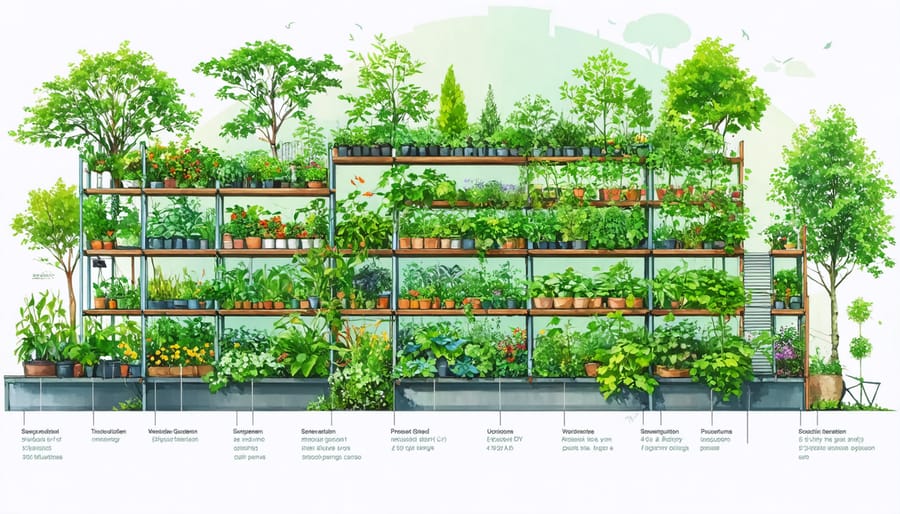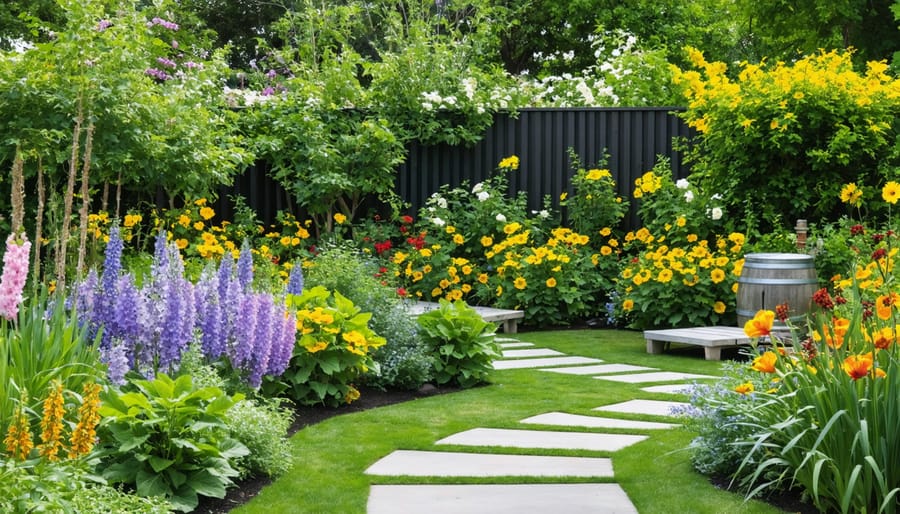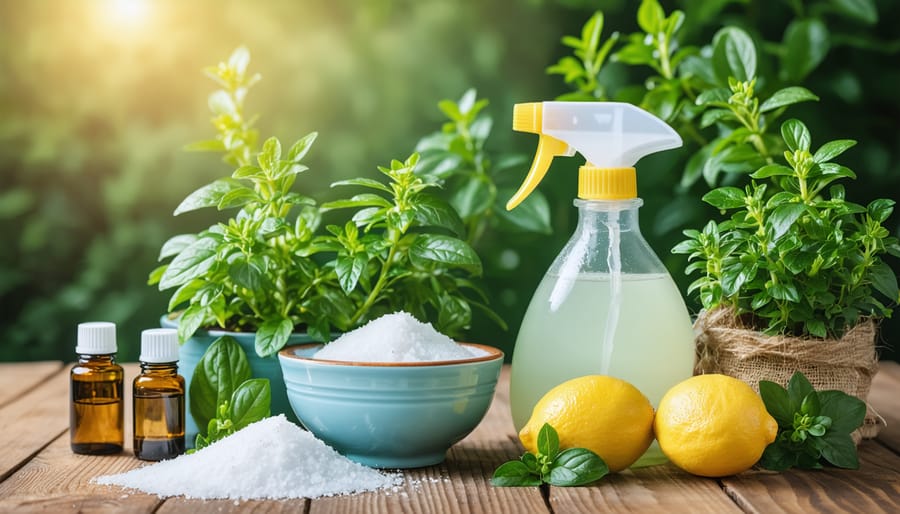Transform your garden into a sustainable ecosystem by starting with three foundational practices today. Collect rainwater in barrels positioned under downspouts, reducing water consumption by up to 40% while providing chemical-free irrigation. Create rich, living soil by establishing a three-bin composting system that turns kitchen scraps and yard waste into nutrient-dense fertilizer within months. Plant companion groups – like basil with tomatoes, or marigolds with vegetables – to naturally deter pests and enhance growth without synthetic pesticides.
Sustainable gardening nurtures both your plants and the environment, creating a thriving space that requires fewer resources while producing better results. Whether you’re tending a small herb garden or managing a large vegetable plot, these ecological practices build healthy soil, conserve water, and support local wildlife – all while reducing your gardening costs and environmental impact. The beauty of sustainable gardening lies in its simplicity: small, intentional changes create lasting positive effects that grow stronger with each passing season.
Smart Water Management That Saves Time and Money
Rainwater Harvesting Made Simple
Rainwater harvesting doesn’t have to be complicated or expensive. In fact, you can start collecting free, natural water for your garden with just a few basic supplies. The simplest method is to position rain barrels beneath your roof’s downspouts. A standard 55-gallon barrel can fill up during just one good rainfall, providing enough water for several weeks of garden maintenance.
For those with larger gardens, consider installing a series of connected barrels or a larger collection tank. Make sure to elevate your containers slightly off the ground using concrete blocks or a sturdy platform – this creates better water pressure and makes it easier to fill watering cans.
Don’t forget to cover your collection containers with fine mesh screens to keep out debris and prevent mosquitoes from breeding. Adding a first-flush diverter can help ensure cleaner water by directing the initial rainfall, which often contains roof debris, away from your storage system.
For maximum efficiency, consider adding a simple drip irrigation system to your rain barrels. This allows for slow, direct watering of your plants’ root zones, reducing water waste through evaporation. During dry spells, your stored rainwater becomes an invaluable resource, helping your garden thrive while conserving municipal water supplies.
Even apartment gardeners can participate by setting up small collection systems on balconies or patios. Every drop counts when it comes to sustainable gardening!
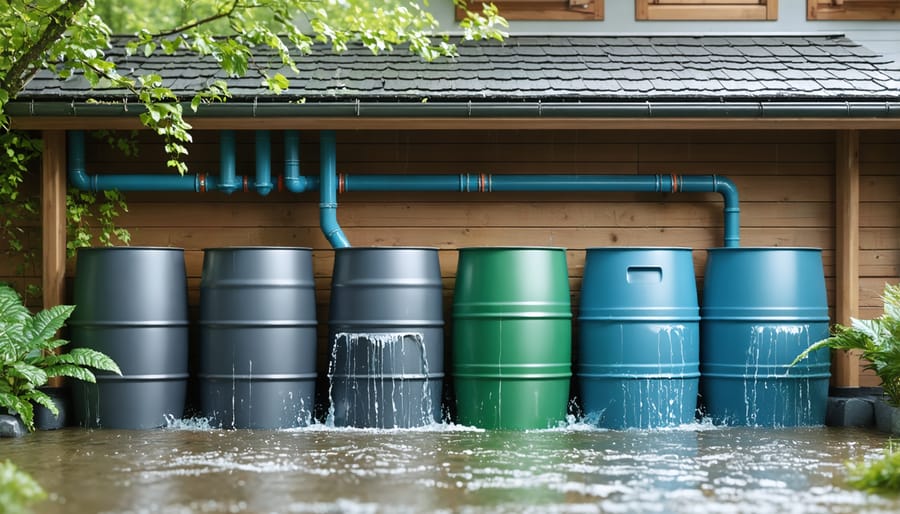
Moisture-Smart Watering Techniques
Water is precious, and using it wisely in your garden not only helps the environment but also promotes healthier plant growth. The key to moisture-smart watering lies in timing and technique. Water early in the morning or late in the evening when evaporation rates are lowest, allowing plants to absorb more moisture.
Consider installing a drip irrigation system, which delivers water directly to plant roots, reducing waste and preventing leaf diseases that can develop from overhead watering. For those on a budget, soaker hoses work wonderfully as an affordable alternative.
Mulching is your secret weapon for moisture retention. Apply a 2-3 inch layer of organic mulch around your plants to keep soil cool and moist. Straw, wood chips, or shredded leaves work beautifully and gradually decompose to enrich your soil.
Get to know your plants’ specific water needs. Group those with similar requirements together to avoid overwatering some while underwatering others. A simple moisture meter can take the guesswork out of when to water, or try the finger test – if the soil feels dry an inch below the surface, it’s time to water.
Collect rainwater in barrels or tanks to use during dry spells. This free resource is perfect for gardens and helps reduce your reliance on municipal water supplies. Remember, deep, infrequent watering encourages stronger root growth than frequent, shallow watering.
Build Rich Soil Without Chemical Fertilizers
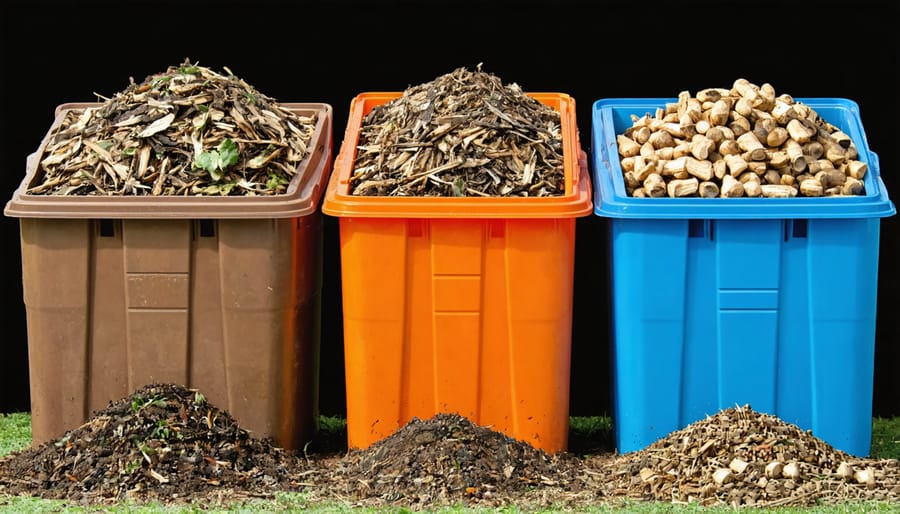
Composting Success Secrets
Creating nutrient-rich compost is like cooking up a gourmet meal for your garden, and it’s easier than you might think! Start by choosing a convenient spot in your yard that’s partially shaded and has good drainage. You’ll need a mix of “green” materials (nitrogen-rich) and “brown” materials (carbon-rich) to create the perfect balance.
For your greens, collect kitchen scraps like fruit and vegetable waste, coffee grounds, and eggshells. Garden clippings, fresh grass, and young weeds make excellent additions too. Your browns should include dry leaves, straw, newspaper, cardboard, and wood chips. Aim for a ratio of roughly three parts brown to one part green materials.
Layer your materials, starting with coarse browns at the bottom for better airflow. Add your materials in alternating layers, keeping them moist but not soggy – think of a wrung-out sponge. Every few weeks, turn your pile with a garden fork to incorporate oxygen, which speeds up decomposition and prevents unpleasant odors.
A healthy compost pile should feel warm in the center and have a pleasant, earthy smell. If it’s too wet or smelly, add more browns. If it’s too dry and decomposing slowly, add greens and some water. Avoid meat, dairy, oils, or diseased plants, as these can attract pests or harm your compost’s quality.
Within 3-6 months, you’ll have dark, crumbly compost that smells like fresh forest soil. When most materials are unrecognizable and the pile no longer heats up, your black gold is ready to enrich your garden beds and container plants.
Remember, successful composting is about observation and adjustment. Don’t worry if it takes some time to get the hang of it – each pile is a learning opportunity!
Natural Soil Amendments
Nature provides everything we need to build healthy garden soil, and the best part is that many of these amendments are free or low-cost. Compost is your garden’s best friend – create your own by combining kitchen scraps, yard waste, and fallen leaves. This “black gold” adds essential nutrients while improving soil structure and water retention.
Coffee grounds are another fantastic amendment that most of us have ready access to. Rich in nitrogen and other minerals, they’re particularly beneficial for acid-loving plants. Many local coffee shops are happy to give away their used grounds to gardeners.
Grass clippings make an excellent nitrogen-rich addition when mixed into your soil or used as mulch. Just be sure they haven’t been treated with chemicals. Crushed eggshells provide calcium and can help prevent blossom end rot in tomatoes and peppers, while banana peels offer potassium-rich nutrients as they decompose.
Don’t overlook the power of green manures – plants like clover, buckwheat, or winter rye that can be grown specifically to be turned back into the soil. These cover crops prevent erosion, add organic matter, and improve soil structure naturally.
Remember to let fallen leaves decompose in your garden beds rather than bagging them up. They’re nature’s way of recycling nutrients and protecting soil through winter months.
Plant Selection for a Resilient Garden
Native Plants That Flourish Naturally
Embracing native plant species in your garden isn’t just a trend – it’s a smart, sustainable choice that brings multiple benefits to your outdoor space. These plants have evolved to thrive in your local climate, requiring significantly less water, fertilizer, and maintenance than non-native alternatives.
Think of native plants as your garden’s natural champions. They’ve spent thousands of years adapting to local rainfall patterns, soil conditions, and even seasonal changes. This means they’re naturally resistant to local pests and diseases, reducing the need for chemical interventions.
When selecting native plants, consider your specific region and growing conditions. Look for varieties that match your garden’s light exposure, soil type, and moisture levels. Popular choices often include wildflowers, native grasses, and indigenous shrubs that provide food and shelter for local wildlife.
Remember to group plants with similar water needs together, creating efficient watering zones. This practice, known as hydrozoning, helps conserve water while ensuring each plant gets exactly what it needs to flourish. Start with a few native plants and gradually expand your collection as you become more comfortable with their care requirements.
Companion Planting Partnerships
Companion planting is like creating the perfect neighborhood in your garden, where plants help each other thrive naturally. Certain plant partnerships can deter pests, enhance growth, and improve flavors without the need for chemical interventions.
Tomatoes and basil are classic companions – basil repels tomato hornworms while improving tomato flavor. Plant marigolds throughout your garden beds; their roots release compounds that deter harmful nematodes and other unwanted insects. Carrots and onions make great garden friends, as onions’ strong scent helps protect carrots from pests.
Create a “Three Sisters” garden by combining corn, climbing beans, and squash. The corn provides support for beans, which fix nitrogen in the soil, while squash leaves shade the ground and prevent weed growth. Nasturtiums act as a sacrificial plant, attracting aphids away from your vegetables while adding edible, peppery flowers to your garden.
For herb gardens, pair rosemary with sage and thyme – they share similar growing requirements and their strong aromas confuse pest insects. Remember to group plants with similar water and sunlight needs together for easier maintenance and better growth outcomes.
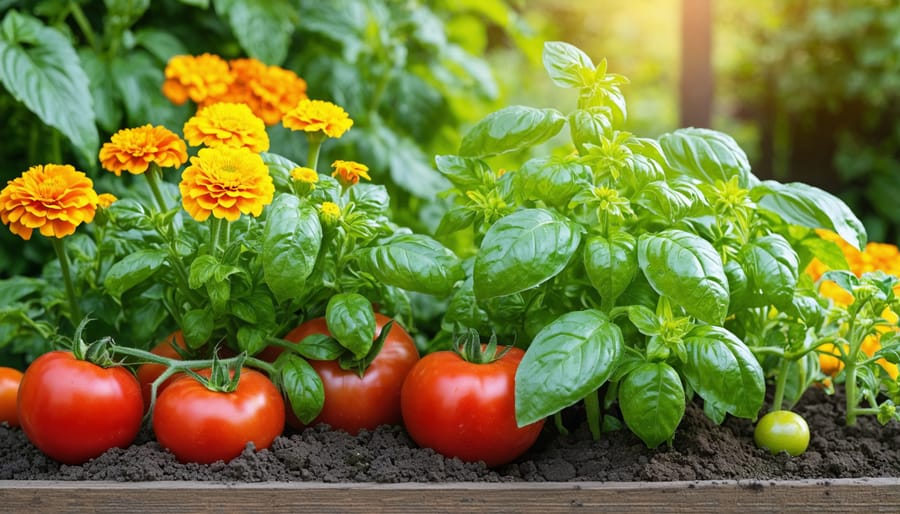
Natural Pest Management That Really Works
Beneficial Insects: Your Garden Allies
While chemical pesticides might seem like a quick fix, your garden’s best defenders are actually the beneficial insects that naturally call it home. These helpful creatures work tirelessly to keep pest populations in check while supporting pollination and maintaining a healthy ecosystem.
Ladybugs, for instance, are natural aphid controllers, with a single adult capable of consuming up to 5,000 aphids in its lifetime. Ground beetles patrol your garden at night, feasting on slugs, snails, and harmful insect larvae. Praying mantises are fascinating predators that help control various garden pests, from caterpillars to grasshoppers.
To attract these garden allies, create a welcoming environment by:
• Planting diverse flowering species that bloom throughout the season
• Including herbs like dill, fennel, and yarrow
• Maintaining areas with leaf litter and shallow water sources
• Avoiding broad-spectrum pesticides that harm beneficial insects
Don’t forget about our busy pollinators! Bees, butterflies, and hover flies not only help with fruit and vegetable production but also add life and movement to your garden. Native flowering plants are particularly effective at attracting these helpful insects.
Remember that a few holes in leaves aren’t always bad news – it’s often a sign that your garden’s natural defense system is working. By supporting beneficial insects, you’re creating a self-regulating ecosystem that requires less intervention from you.
Organic Pest Solutions
Keeping your garden pest-free doesn’t mean reaching for harmful chemicals. Nature provides countless effective solutions that protect both your plants and beneficial insects. Start by companion planting – marigolds, nasturtiums, and lavender naturally repel many common pests while adding beauty to your garden. These fragrant flowers act as natural guardians for your vegetables and herbs.
For existing pest problems, try making your own organic sprays. A simple solution of neem oil and water works wonders against aphids, mites, and other soft-bodied insects. Alternatively, mix garlic and hot pepper with water to create a natural deterrent that most pests can’t stand. Remember to spray in the early morning or evening to avoid leaf burn.
Encourage beneficial insects like ladybugs, praying mantises, and parasitic wasps by creating diverse habitats. Leave some wild areas in your garden and include shallow water sources. These helpful creatures naturally control pest populations, maintaining a healthy ecosystem balance.
Physical barriers offer another effective solution. Use row covers for young plants, create copper tape barriers for slugs, and install bird netting to protect fruits. Coffee grounds scattered around plants deter slugs and cats while enriching your soil.
Remember, a healthy garden is naturally more resistant to pests. Focus on building rich soil, practicing crop rotation, and maintaining proper plant spacing to prevent pest problems before they start.
As we’ve explored throughout this guide, sustainable gardening isn’t just a trend – it’s a rewarding way to nurture both your garden and our planet. By implementing these eco-friendly practices, you’re joining a growing community of gardeners who are making a real difference in their local environments.
Remember that every small step counts. Whether you’re starting with a simple compost bin, installing a rain barrel, or transitioning to organic pest control methods, each sustainable choice contributes to a healthier garden ecosystem. The beauty of sustainable gardening lies in its adaptability – you can start small and gradually incorporate more practices as you become comfortable with each technique.
The benefits extend far beyond your garden beds. You’ll notice reduced water bills, healthier soil, more abundant harvests, and an increase in beneficial wildlife visiting your garden. Plus, there’s something incredibly satisfying about knowing your garden works in harmony with nature rather than against it.
Don’t feel pressured to implement everything at once. Choose one or two practices that resonate with you and build from there. Whether you’re a seasoned gardener or just starting, sustainable gardening is an ongoing journey of learning and discovery.
As you move forward with your sustainable gardening journey, remember that every garden, no matter how small, has the potential to make a positive environmental impact. Your efforts today will help create a greener, more sustainable future for generations to come.


